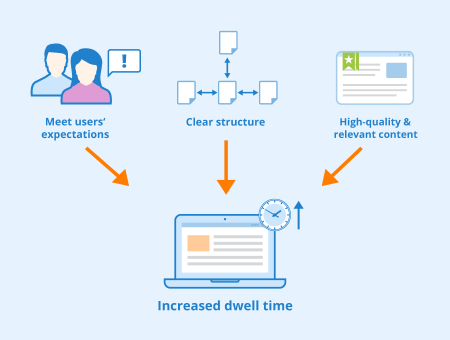Dwell Time
Contents
Definition
Dwell time is the total amount of time a user spends on a particular website. In addition to the bounce rate, this is an important indicator for evaluating the quality of website content.
Importance of dwell time for a website’s ranking
The question if search engines actually use visitor dwell time as a ranking signal has been discussed controversially by SEOs for years. As with almost everything concerning its algorithms, Google keeps a low profile on this question and does not provide any definitive information. In general, however, people assume that search engines do consider dwell time as a ranking factor. One of the reasons for this assumption is that Google, for example, aims to provide search engine users with exactly the results that answer their search queries comprehensively. Google wants to offer its users the information they are really looking for on every topic. The average time spent is an indication that a website meets these requirements and is therefore likely to be used as a ranking factor.
Increasing dwell times

Internet users visit a website with specific expectations. For example, they might be looking for a solution to a problem, information about products, or even a purchase. The better a website meets these expectations, the longer the average time a visitor spends on it.
For this reason, a website should make it as easy as possible for visitors to satisfy their needs. This includes a structure that is clear and intuitive to use. Consumers should be able to navigate easily through the pages while not having to spend much time searching. Pictures, embedded videos, as well as links to related topics can make your content more attractive to readers, offer additional information, and increase dwell time.
Last but not least, a website's content should always deliver what the title and description shown in the search results promise search engine users.
Significance
Despite its importance for assessing a website’s quality, the informative value of dwell times should always be questioned. This is because of the way Google Analytics calculates them. A page load or event trigger is referred to as a hit and Google Analytics sets a timestamp for each of these hits. The dwell time is then determined by the difference between the time of the first and the last hit. This means that at least two page views (or events) are required for Google Analytics to measure the time span.
If users load only one page and do not trigger any events, the duration of the visit will be set to 0, even if they have been on the page for a long time. This means that the average dwell time indicated by Analytics tends to be lower than the actual time.
Users that have many browser tabs opened at once can also lead to distortions in the average dwell time. This is the case when users open several websites, e.g. news portals, in separate browser tabs and read them one after another. In this case, visitors are only active on one page at a time. When they reach the last tab and scroll through it, the page has been open for a while and Analytics measures a long dwell time. This has nothing to do with the actual dwell time, which may only be a few seconds.
Short dwell time, on the other hand, does not necessarily mean that the content is not helpful for visitors. Web pages that quickly provide visitors with the desired information are usually left after a short time. Likewise, short stays can occur when the requested information is rather limited, such as contact information. However, if short dwell times coincide with a high bounce rate, this indicates a user behavior known as "pogo sticking", which is triggered by content with little relevance to the users' search queries. With "pogo sticking", consumers jump from SERPs to a website and return to the search results soon after to visit another website.
There is no general guideline specifying sufficient dwell times for websites. The suitable dwell time is certainly shorter for a hair salon's website than for a website providing technical or medical information.
Related links
| About the author |
 |